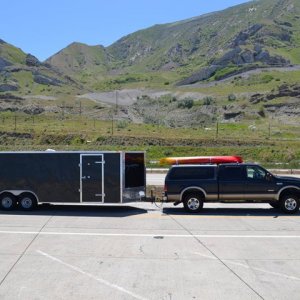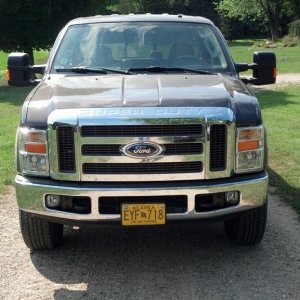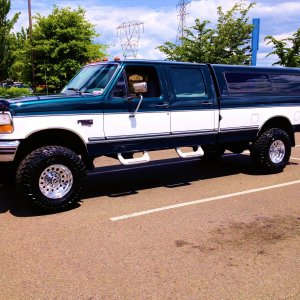You are using an out of date browser. It may not display this or other websites correctly.
You should upgrade or use an alternative browser.
You should upgrade or use an alternative browser.
7.3 intermitent engine shake
- Thread starter Yerkie
- Start date
Ok do I have to pull the single glow plug with that cylinder?
I was just gonna
-pull idm fuse/relay
-hand turn motor 3-4 times each way
-turn key without idm fuse
-hand turn again
Also do I need to evacuate the cylinder before I put the injector in or after?
I was just gonna
-pull idm fuse/relay
-hand turn motor 3-4 times each way
-turn key without idm fuse
-hand turn again
Also do I need to evacuate the cylinder before I put the injector in or after?
lincolnlocker
Well-known member
pull glow plug out of the cylinder you removed the injector from.Ok do I have to pull the single glow plug with that cylinder?
I was just gonna
-pull idm fuse/relay
-hand turn motor 3-4 times each way
-turn key without idm fuse
-hand turn again
Also do I need to evacuate the cylinder before I put the injector in or after?
after new injector is in, put valve cover back on and bar the motor over 4 or 5 revolutions.
bump the key 4 or 5 times.
pull vc off and replace glow plug
start motor and watch it run for a sec
put it back together and drive the piss outta it to rid any air in the system.
live life full throttle
79jasper
Active member
Mine has been gone since 04...
Exactly. Mine was in perfect shape though. Lol
Now the fender well pieces, not so much. Already ripped the driver side out. Passenger is next when I get a chance.
Sent from my SAMSUNG-SM-G890A using Tapatalk
I'm wondering which self-test app to buy? (Car gauge pro or torque pro)
Do any of the apps allow you to view each cylinder while it's running?
Cause I would like to see how the truck is running before and after I play with the injectors
Do any of the apps allow you to view each cylinder while it's running?
Cause I would like to see how the truck is running before and after I play with the injectors
Ok so I have the new injector in my hand and I have let the truck idle till the shudder problem starts and when I unplug injector #5 that's suppose to be weak it cause the engine to drop in rpm like the rest of the injectors 1,3,5,7 none of them seem different, leaking oil out of the orings and they are spitting oil out the back like they should.
I'm hoping this fixes my problem but, any ideas?
I'm hoping this fixes my problem but, any ideas?
Ok I replaced injector #5 and of course took a little bit to get it started after I purged it.
After running it maybe 5-7 miles as hard as I can around here it still is shaking like it did (a little worse)but I think that it cause there is still air and what not in the system.
I'm not sure what to do next I'm getting one of those Bluetooth plugs tomorrow but, still not sure how to view each cylinder (cct) with either of the apps
After running it maybe 5-7 miles as hard as I can around here it still is shaking like it did (a little worse)but I think that it cause there is still air and what not in the system.
I'm not sure what to do next I'm getting one of those Bluetooth plugs tomorrow but, still not sure how to view each cylinder (cct) with either of the apps
lincolnlocker
Well-known member
you need to drivebit hard for 50 to 100 miles then see what happens.Ok I replaced injector #5 and of course took a little bit to get it started after I purged it.
After running it maybe 5-7 miles as hard as I can around here it still is shaking like it did (a little worse)but I think that it cause there is still air and what not in the system.
I'm not sure what to do next I'm getting one of those Bluetooth plugs tomorrow but, still not sure how to view each cylinder (cct) with either of the apps
live life full throttle
I've never had these extended runs to cclear shti out. Last injector change, which was three weeks ago, i put them in and cranked it three times. It fired on #2, died. Started it the third time and after three blocks of throttle. Smooth as glass.
Arisley
Moderator
Yeah, but you are just so skeery that the motor is afraid not to do right.
Actually, me too. I get it started after a couple or three tries, let it idle with a couple romps on the throttle. Back it out of the driveway, do a boosted launch or three. Call it done.
Actually, me too. I get it started after a couple or three tries, let it idle with a couple romps on the throttle. Back it out of the driveway, do a boosted launch or three. Call it done.
dsberman94
Well-known member
You guys saying I'm the only person who has a metric chit ton of white and blue afterwards?
ghohouston
Active member
^some trucks do, and some don't. Same with 6.0's after injectors, some will smoke out a shop, some wont.
Arisley
Moderator
You guys saying I'm the only person who has a metric chit ton of white and blue afterwards?
A lot of it is purging the oil and fuel out of the heads before pulling injectors. It is simply a couple more steps.
You guys saying I'm the only person who has a metric chit ton of white and blue afterwards?
completely normal.
if all...allllll the fuel & oil isn't evacuated from the cylinders before cranking, those fluids will be pushed out of the exhaust valves, into the exh manifolds...into the exhaust system, muffler, etc...and once the exhaust is coated with oil & fuel...it takes quite a bit of driving (and exh temperature) to get the oil/fuel burned off..
*I* would never recommend plopping an injector in, firing it up and revving it too hard...the fuel system on these trucks (stock) pretty much sucks (see regulated return system)..so it's very likely that the air trapped in the cylinder head (fuel passages) will need to be purged through the injector itself.
the HPOil side of the injector is going to purge quite quickly...however on a stock (dead head) fuel system, the air trapped in the fuel rail is very likely to cause internal injector damage (scoring the plunger & barrel assembly) from not having fuel inside the injector to lubricate and cushion the (very) tight tolerance components within the injector.
less caution is required if a truck has a RR fuel system, but it does take time for the fuel to get into the injector.
10-12 years ago, prior to us having an injector flowbench, we would often install injectors into a customers truck, drive it around the block, 2-3-4 miles, and the truck would have a dead freaking misfire...not having the experience we do now, we would sometimes (prematurely) pull 'the' injector, tear it down to inspect it, only to find that the internals of the injector were still bone dry...not a drop of fuel to be found.
my recommendation is to drive it easy, low rpm for 20 miles (if no RR fuel sys is installed)...and then plan on another 20-30 miles to get the air completely worked out of the head(s).
Get it started, go park nosedown on a steep hill 
Now that you say that with stock fuel and oil my 175/80s sounded "soft" for two or three minutes of idling. Im assuming air in the oilside.
Since aftermarket fuel and oil it is easy. When you turn the key now, you can hear the air moving through the fuel rail.
Now that you say that with stock fuel and oil my 175/80s sounded "soft" for two or three minutes of idling. Im assuming air in the oilside.
Since aftermarket fuel and oil it is easy. When you turn the key now, you can hear the air moving through the fuel rail.
lincolnlocker
Well-known member
awesome post as usual sir. by now you prolly just copy and paste from all the years of posting the same info I'd imagine. lolcompletely normal.
if all...allllll the fuel & oil isn't evacuated from the cylinders before cranking, those fluids will be pushed out of the exhaust valves, into the exh manifolds...into the exhaust system, muffler, etc...and once the exhaust is coated with oil & fuel...it takes quite a bit of driving (and exh temperature) to get the oil/fuel burned off..
*I* would never recommend plopping an injector in, firing it up and revving it too hard...the fuel system on these trucks (stock) pretty much sucks (see regulated return system)..so it's very likely that the air trapped in the cylinder head (fuel passages) will need to be purged through the injector itself.
the HPOil side of the injector is going to purge quite quickly...however on a stock (dead head) fuel system, the air trapped in the fuel rail is very likely to cause internal injector damage (scoring the plunger & barrel assembly) from not having fuel inside the injector to lubricate and cushion the (very) tight tolerance components within the injector.
less caution is required if a truck has a RR fuel system, but it does take time for the fuel to get into the injector.
10-12 years ago, prior to us having an injector flowbench, we would often install injectors into a customers truck, drive it around the block, 2-3-4 miles, and the truck would have a dead freaking misfire...not having the experience we do now, we would sometimes (prematurely) pull 'the' injector, tear it down to inspect it, only to find that the internals of the injector were still bone dry...not a drop of fuel to be found.
my recommendation is to drive it easy, low rpm for 20 miles (if no RR fuel sys is installed)...and then plan on another 20-30 miles to get the air completely worked out of the head(s).
live life full throttle
Ok so I've had enough time to run the air/oil what not out about 120 miles since. After first running it I could smoke out the whole block out but it's running now the same as before with that shudder/shake to it. I used the Bluetooth plug in with torque pro (car gauge pro won't connect) and the only thing I can read is the rpms fluctuating from 650 to 700...
Do you guys know how to connect it to read fuel pressure? It won't register it when the rpms are registering fine...
Do you guys know how to connect it to read fuel pressure? It won't register it when the rpms are registering fine...
lincolnlocker
Well-known member
you cant read fuel pressure on a 7.3... no sensor. have to buyba mechanical gauge. i dont know about the cargaugepro but with the torque pro you have to load the powerstroke specific PID's from a website i posted in my torque app thread.
live life full throttle
live life full throttle
Arisley
Moderator
No monitor will read fuel pressure on a 7.3, Not reported to the PCM. You have to have a standalone gauge. Some systems (Scanguage), you can get a sensor, plug it into the gauge, just like EGT's, it will then tell you reading from the sensor instead of the PCM.
Latest posts
-
Will a 1996 F6TZ-9A451-F engine wiring harness work on a 1997 f250 HD ?
- Latest: 6.7powersmoke
-
-
-
-












